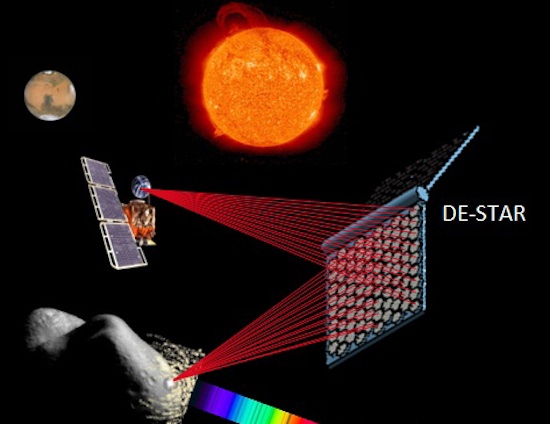Researchers Propose Giant Space Laser for Fending Off Future Asteroids
Frightened of rocks from outer space falling on your head today? You can be forgiven for that, as it’s a going concern this afternoon. Researchers at the University of California — Santa Barbara and California Polytechnic State University are proposing a way to put your troubled mind at ease, though. They want to launch an array of solar-powered lasers into orbit that they say could not only deflect or vaporize incoming asteroids, but also be put to uses like powering future spacecraft as they explore the solar system.
The proposed system, known as DE-STAR, or Directed Energy Solar Targeting of Asteroids an exploRation, would harness solar energy and focus it into laser beams that the team behind it claims could evaporate incoming asteroids that were deemed a threat to Earth. As a “directed energy orbital defense system,” it’s not too different from proposed SDS or “Star Wars” defense systems that were such a popular notion in the 1980s.
Getting a system like this off the ground is still a pretty far-flung proposition, though researchers say that’s not a failure of technology, but of will. According to Cal Poly’s Gary Hughes, one of the researchers behind DE-STAR:
“This system is not some far-out idea from Star Trek. All the components of this system pretty much exist today. Maybe not quite at the scale that we’d need –– scaling up would be the challenge –– but the basic elements are all there and ready to go. We just need to put them into a larger system to be effective, and once the system is there, it can do so many things.”
Those things include opening new possibilities for wanna be asteroid mining companies, analyzing the mineral makeup of asteroids and even deflecting them onto trajectories that are more stable for mining purposes. It could also help provide power for spaceships. Mostly though, let’s face it — the thing is for zapping asteroids out of the sky, presumably while the system’s controller makes ‘pew-pew’ noises. Though, with an advanced defense system like this, we have to assume that’s a built-in feature.
(via UCSB)
- You can watch an asteroid zing uncomfortably close to Earth right now
- Apparently, we need this sort of thing
- Because of space rocks trying to do murder to us
Have a tip we should know? tips@themarysue.com
